Holmes Institute HI6028 Taxation Law Assignment T3 2019
VerifiedAdded on 2022/08/20
|12
|2873
|27
Homework Assignment
AI Summary
This assignment addresses various aspects of Australian taxation law, covering ordinary income, fringe benefits, and capital gains tax (CGT). The first part examines the tax implications of income earned from personal services, including tips and employment income, and the treatment of gifts. It references key cases and legislation such as ITAA 1997 and FBTAA 1986. The second part delves into CGT, differentiating between pre-CGT and post-CGT assets and explaining the tax treatment of personal use assets. It also covers small business CGT concessions, including asset ownership exemptions and retirement exemptions, as well as the rules for collectables. The assignment provides practical application through case studies, analyzing scenarios involving employment income, gifts, and asset disposals, and determining the relevant tax implications for each. The document is a solution to the assignment brief provided, aiming to demonstrate understanding of the Australian tax system and its application to real-world scenarios.
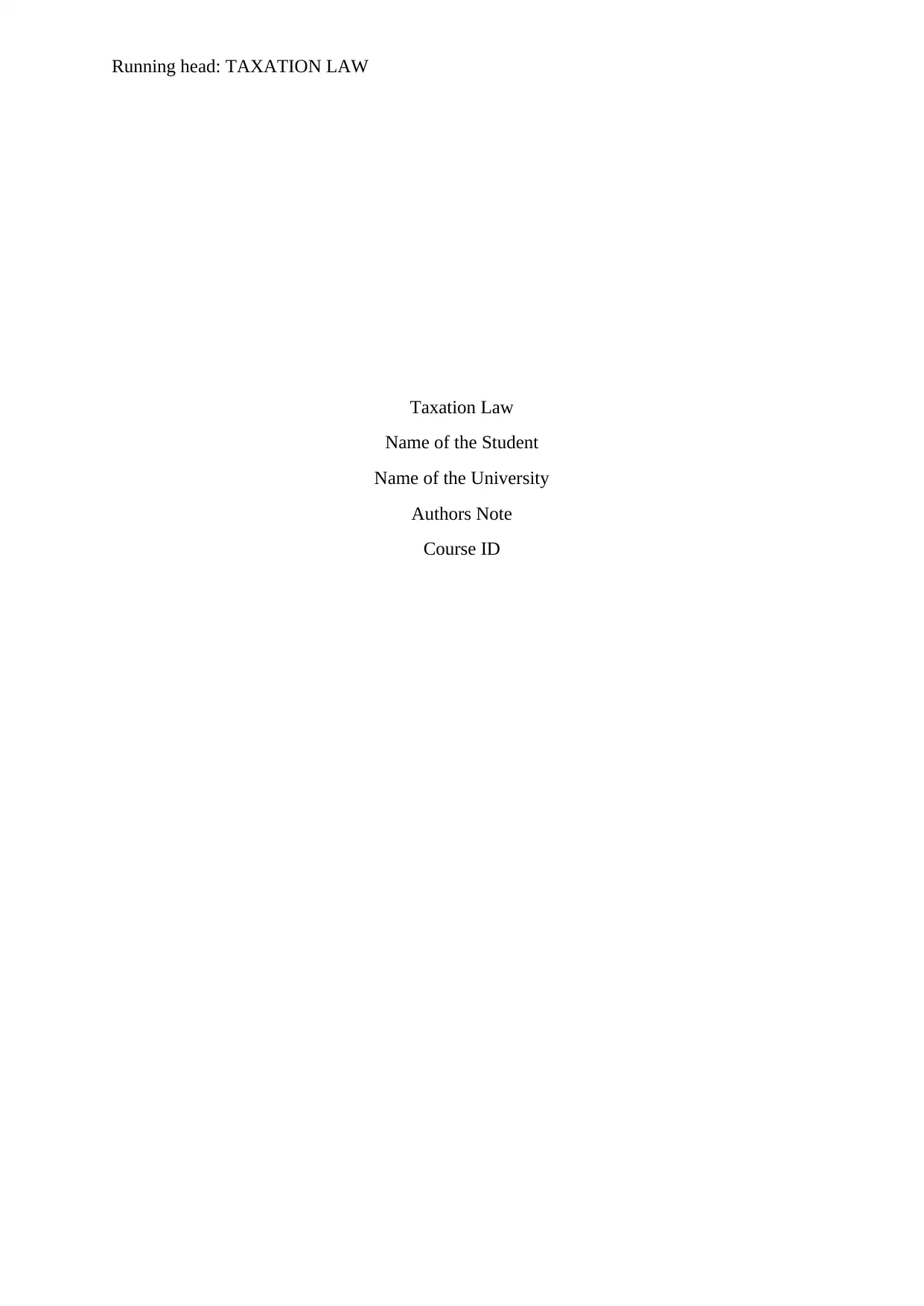
Running head: TAXATION LAW
Taxation Law
Name of the Student
Name of the University
Authors Note
Course ID
Taxation Law
Name of the Student
Name of the University
Authors Note
Course ID
Paraphrase This Document
Need a fresh take? Get an instant paraphrase of this document with our AI Paraphraser
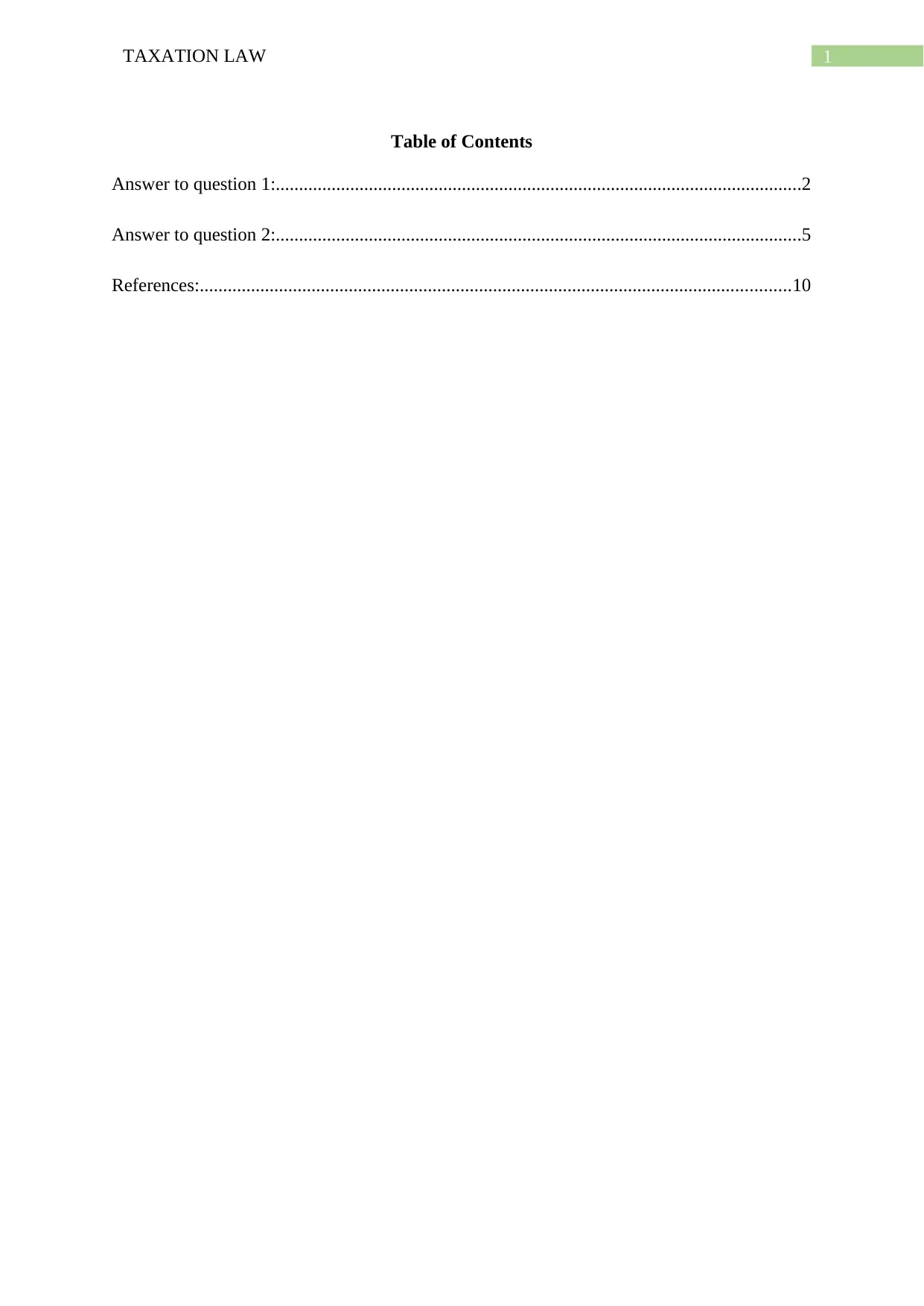
1TAXATION LAW
Table of Contents
Answer to question 1:.................................................................................................................2
Answer to question 2:.................................................................................................................5
References:...............................................................................................................................10
Table of Contents
Answer to question 1:.................................................................................................................2
Answer to question 2:.................................................................................................................5
References:...............................................................................................................................10
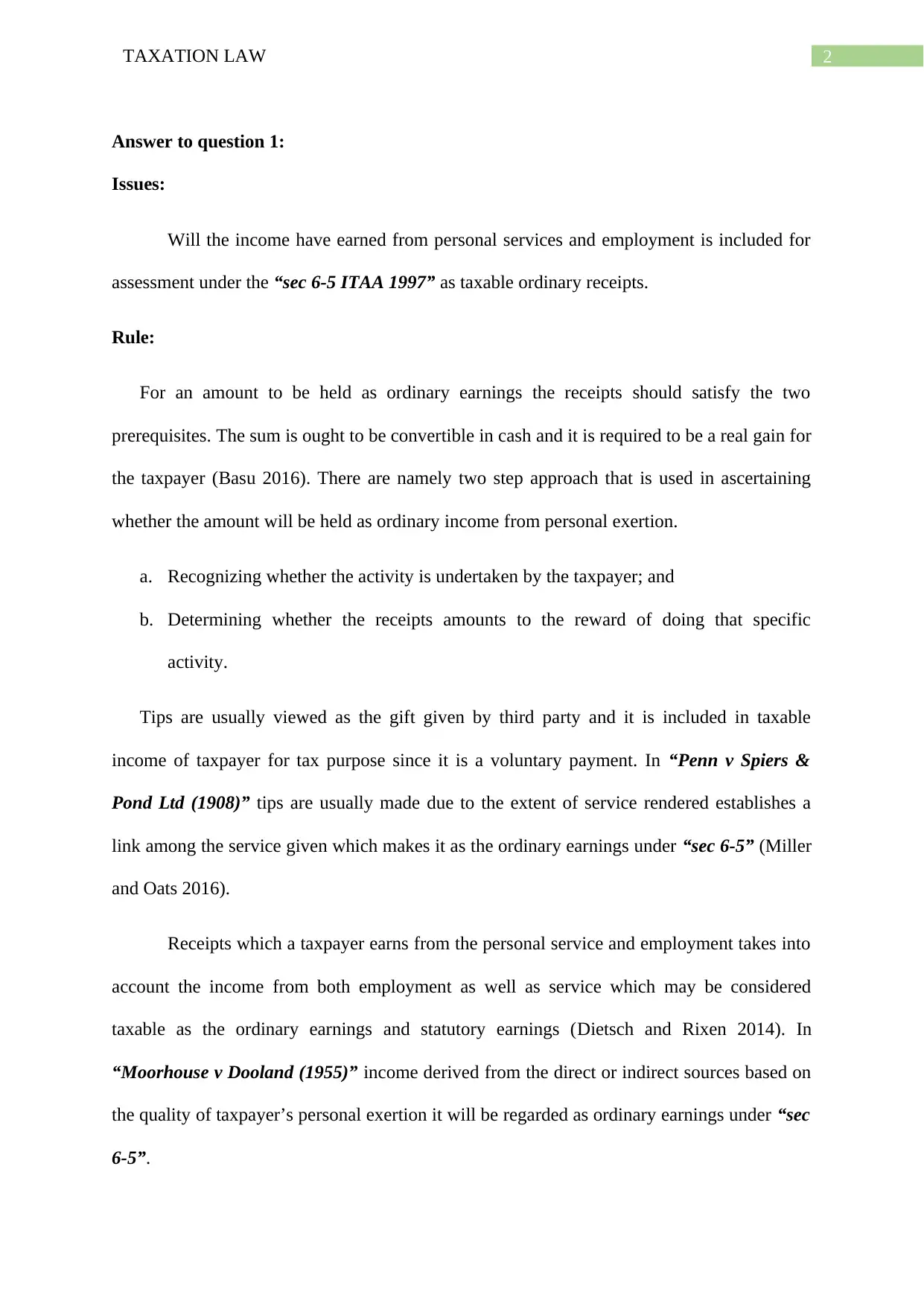
2TAXATION LAW
Answer to question 1:
Issues:
Will the income have earned from personal services and employment is included for
assessment under the “sec 6-5 ITAA 1997” as taxable ordinary receipts.
Rule:
For an amount to be held as ordinary earnings the receipts should satisfy the two
prerequisites. The sum is ought to be convertible in cash and it is required to be a real gain for
the taxpayer (Basu 2016). There are namely two step approach that is used in ascertaining
whether the amount will be held as ordinary income from personal exertion.
a. Recognizing whether the activity is undertaken by the taxpayer; and
b. Determining whether the receipts amounts to the reward of doing that specific
activity.
Tips are usually viewed as the gift given by third party and it is included in taxable
income of taxpayer for tax purpose since it is a voluntary payment. In “Penn v Spiers &
Pond Ltd (1908)” tips are usually made due to the extent of service rendered establishes a
link among the service given which makes it as the ordinary earnings under “sec 6-5” (Miller
and Oats 2016).
Receipts which a taxpayer earns from the personal service and employment takes into
account the income from both employment as well as service which may be considered
taxable as the ordinary earnings and statutory earnings (Dietsch and Rixen 2014). In
“Moorhouse v Dooland (1955)” income derived from the direct or indirect sources based on
the quality of taxpayer’s personal exertion it will be regarded as ordinary earnings under “sec
6-5”.
Answer to question 1:
Issues:
Will the income have earned from personal services and employment is included for
assessment under the “sec 6-5 ITAA 1997” as taxable ordinary receipts.
Rule:
For an amount to be held as ordinary earnings the receipts should satisfy the two
prerequisites. The sum is ought to be convertible in cash and it is required to be a real gain for
the taxpayer (Basu 2016). There are namely two step approach that is used in ascertaining
whether the amount will be held as ordinary income from personal exertion.
a. Recognizing whether the activity is undertaken by the taxpayer; and
b. Determining whether the receipts amounts to the reward of doing that specific
activity.
Tips are usually viewed as the gift given by third party and it is included in taxable
income of taxpayer for tax purpose since it is a voluntary payment. In “Penn v Spiers &
Pond Ltd (1908)” tips are usually made due to the extent of service rendered establishes a
link among the service given which makes it as the ordinary earnings under “sec 6-5” (Miller
and Oats 2016).
Receipts which a taxpayer earns from the personal service and employment takes into
account the income from both employment as well as service which may be considered
taxable as the ordinary earnings and statutory earnings (Dietsch and Rixen 2014). In
“Moorhouse v Dooland (1955)” income derived from the direct or indirect sources based on
the quality of taxpayer’s personal exertion it will be regarded as ordinary earnings under “sec
6-5”.
⊘ This is a preview!⊘
Do you want full access?
Subscribe today to unlock all pages.

Trusted by 1+ million students worldwide
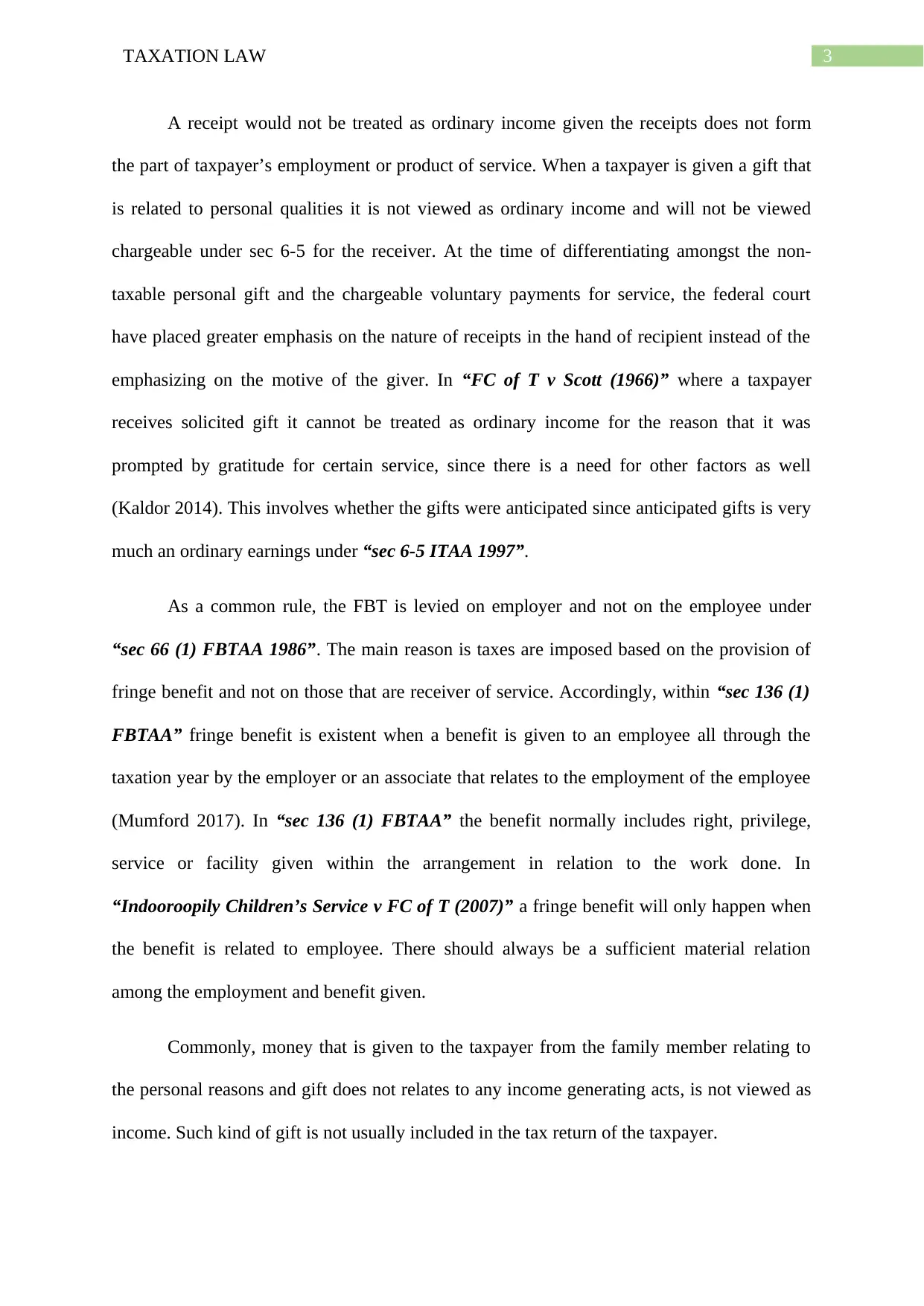
3TAXATION LAW
A receipt would not be treated as ordinary income given the receipts does not form
the part of taxpayer’s employment or product of service. When a taxpayer is given a gift that
is related to personal qualities it is not viewed as ordinary income and will not be viewed
chargeable under sec 6-5 for the receiver. At the time of differentiating amongst the non-
taxable personal gift and the chargeable voluntary payments for service, the federal court
have placed greater emphasis on the nature of receipts in the hand of recipient instead of the
emphasizing on the motive of the giver. In “FC of T v Scott (1966)” where a taxpayer
receives solicited gift it cannot be treated as ordinary income for the reason that it was
prompted by gratitude for certain service, since there is a need for other factors as well
(Kaldor 2014). This involves whether the gifts were anticipated since anticipated gifts is very
much an ordinary earnings under “sec 6-5 ITAA 1997”.
As a common rule, the FBT is levied on employer and not on the employee under
“sec 66 (1) FBTAA 1986”. The main reason is taxes are imposed based on the provision of
fringe benefit and not on those that are receiver of service. Accordingly, within “sec 136 (1)
FBTAA” fringe benefit is existent when a benefit is given to an employee all through the
taxation year by the employer or an associate that relates to the employment of the employee
(Mumford 2017). In “sec 136 (1) FBTAA” the benefit normally includes right, privilege,
service or facility given within the arrangement in relation to the work done. In
“Indooroopily Children’s Service v FC of T (2007)” a fringe benefit will only happen when
the benefit is related to employee. There should always be a sufficient material relation
among the employment and benefit given.
Commonly, money that is given to the taxpayer from the family member relating to
the personal reasons and gift does not relates to any income generating acts, is not viewed as
income. Such kind of gift is not usually included in the tax return of the taxpayer.
A receipt would not be treated as ordinary income given the receipts does not form
the part of taxpayer’s employment or product of service. When a taxpayer is given a gift that
is related to personal qualities it is not viewed as ordinary income and will not be viewed
chargeable under sec 6-5 for the receiver. At the time of differentiating amongst the non-
taxable personal gift and the chargeable voluntary payments for service, the federal court
have placed greater emphasis on the nature of receipts in the hand of recipient instead of the
emphasizing on the motive of the giver. In “FC of T v Scott (1966)” where a taxpayer
receives solicited gift it cannot be treated as ordinary income for the reason that it was
prompted by gratitude for certain service, since there is a need for other factors as well
(Kaldor 2014). This involves whether the gifts were anticipated since anticipated gifts is very
much an ordinary earnings under “sec 6-5 ITAA 1997”.
As a common rule, the FBT is levied on employer and not on the employee under
“sec 66 (1) FBTAA 1986”. The main reason is taxes are imposed based on the provision of
fringe benefit and not on those that are receiver of service. Accordingly, within “sec 136 (1)
FBTAA” fringe benefit is existent when a benefit is given to an employee all through the
taxation year by the employer or an associate that relates to the employment of the employee
(Mumford 2017). In “sec 136 (1) FBTAA” the benefit normally includes right, privilege,
service or facility given within the arrangement in relation to the work done. In
“Indooroopily Children’s Service v FC of T (2007)” a fringe benefit will only happen when
the benefit is related to employee. There should always be a sufficient material relation
among the employment and benefit given.
Commonly, money that is given to the taxpayer from the family member relating to
the personal reasons and gift does not relates to any income generating acts, is not viewed as
income. Such kind of gift is not usually included in the tax return of the taxpayer.
Paraphrase This Document
Need a fresh take? Get an instant paraphrase of this document with our AI Paraphraser
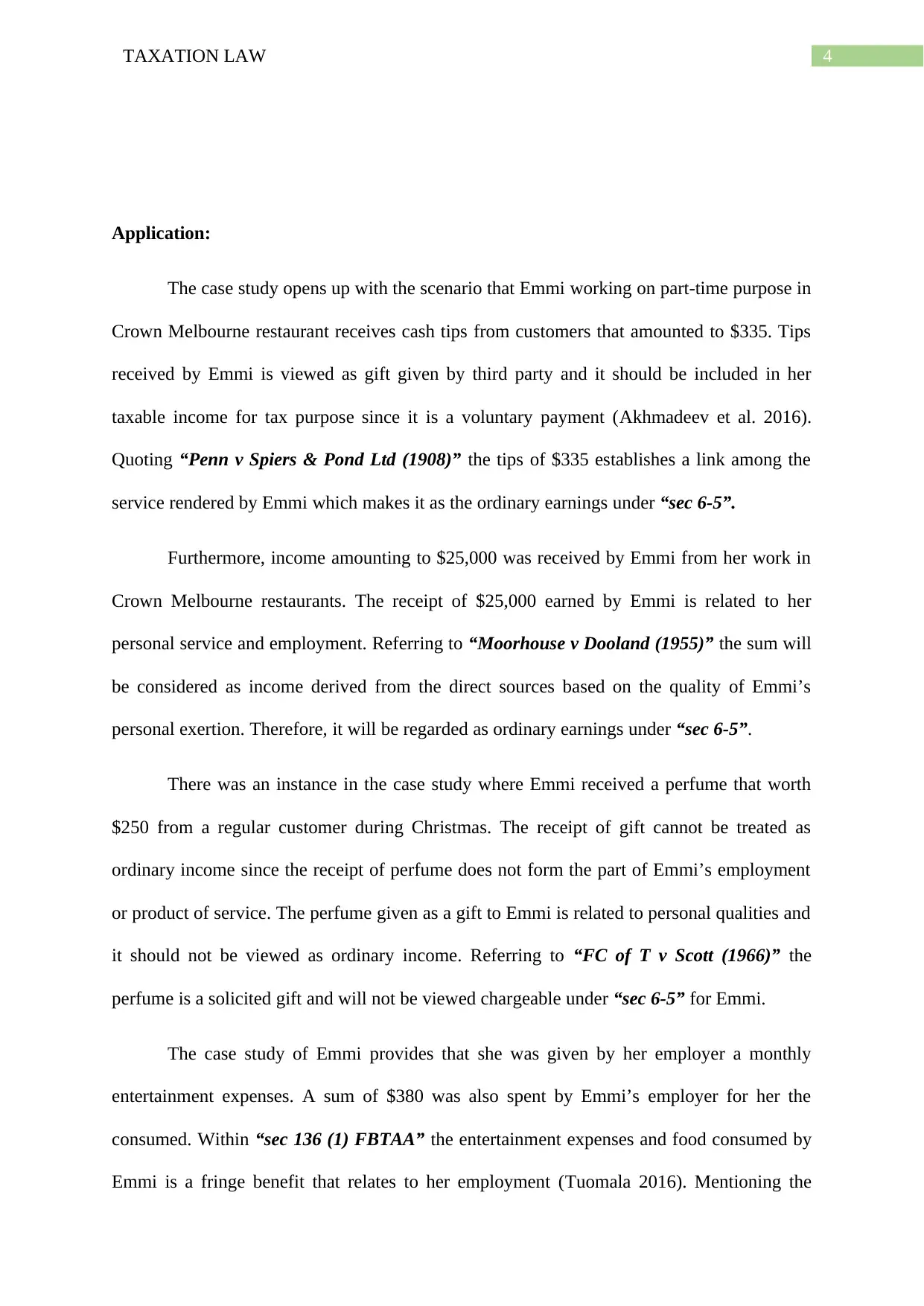
4TAXATION LAW
Application:
The case study opens up with the scenario that Emmi working on part-time purpose in
Crown Melbourne restaurant receives cash tips from customers that amounted to $335. Tips
received by Emmi is viewed as gift given by third party and it should be included in her
taxable income for tax purpose since it is a voluntary payment (Akhmadeev et al. 2016).
Quoting “Penn v Spiers & Pond Ltd (1908)” the tips of $335 establishes a link among the
service rendered by Emmi which makes it as the ordinary earnings under “sec 6-5”.
Furthermore, income amounting to $25,000 was received by Emmi from her work in
Crown Melbourne restaurants. The receipt of $25,000 earned by Emmi is related to her
personal service and employment. Referring to “Moorhouse v Dooland (1955)” the sum will
be considered as income derived from the direct sources based on the quality of Emmi’s
personal exertion. Therefore, it will be regarded as ordinary earnings under “sec 6-5”.
There was an instance in the case study where Emmi received a perfume that worth
$250 from a regular customer during Christmas. The receipt of gift cannot be treated as
ordinary income since the receipt of perfume does not form the part of Emmi’s employment
or product of service. The perfume given as a gift to Emmi is related to personal qualities and
it should not be viewed as ordinary income. Referring to “FC of T v Scott (1966)” the
perfume is a solicited gift and will not be viewed chargeable under “sec 6-5” for Emmi.
The case study of Emmi provides that she was given by her employer a monthly
entertainment expenses. A sum of $380 was also spent by Emmi’s employer for her the
consumed. Within “sec 136 (1) FBTAA” the entertainment expenses and food consumed by
Emmi is a fringe benefit that relates to her employment (Tuomala 2016). Mentioning the
Application:
The case study opens up with the scenario that Emmi working on part-time purpose in
Crown Melbourne restaurant receives cash tips from customers that amounted to $335. Tips
received by Emmi is viewed as gift given by third party and it should be included in her
taxable income for tax purpose since it is a voluntary payment (Akhmadeev et al. 2016).
Quoting “Penn v Spiers & Pond Ltd (1908)” the tips of $335 establishes a link among the
service rendered by Emmi which makes it as the ordinary earnings under “sec 6-5”.
Furthermore, income amounting to $25,000 was received by Emmi from her work in
Crown Melbourne restaurants. The receipt of $25,000 earned by Emmi is related to her
personal service and employment. Referring to “Moorhouse v Dooland (1955)” the sum will
be considered as income derived from the direct sources based on the quality of Emmi’s
personal exertion. Therefore, it will be regarded as ordinary earnings under “sec 6-5”.
There was an instance in the case study where Emmi received a perfume that worth
$250 from a regular customer during Christmas. The receipt of gift cannot be treated as
ordinary income since the receipt of perfume does not form the part of Emmi’s employment
or product of service. The perfume given as a gift to Emmi is related to personal qualities and
it should not be viewed as ordinary income. Referring to “FC of T v Scott (1966)” the
perfume is a solicited gift and will not be viewed chargeable under “sec 6-5” for Emmi.
The case study of Emmi provides that she was given by her employer a monthly
entertainment expenses. A sum of $380 was also spent by Emmi’s employer for her the
consumed. Within “sec 136 (1) FBTAA” the entertainment expenses and food consumed by
Emmi is a fringe benefit that relates to her employment (Tuomala 2016). Mentioning the

5TAXATION LAW
verdict in “Indooroopily Children’s Service v FC of T (2007)” the food and entertainment
benefit is in respect of the employment of Emmi. The benefits hold a sufficient material
relation among the employment and benefit given. Within the “sec 66 (1) FBTAA 1986” the
employer of Emmi will be considered taxable for the value of fringe benefit given to her
during the taxable FBT year.
Finally, during the year, the father of Emmi gave her money that amounted to $15,000
as her Christmas gift. The money that is given to Emmi from her father is linked to her
personal reasons and amounts to gift which does not relates to any income generating acts.
Such kind of gift will not be included in Emmi’s tax return. The taxable income of Emmi is
computed below;
Conclusion:
The case comes to a conclusion that Emmi will be held chargeable under sec 6-5
ITAA 1997 for income received from her part-time employment. She is required to declare in
her taxable income the salary and tips received while her employer will be taxable for fringe
benefit given in the form of entertainment and food consumed. The gift received from her
father and customer is not an income because it is not related to any income generating acts.
Answer to question 2:
Answer A:
verdict in “Indooroopily Children’s Service v FC of T (2007)” the food and entertainment
benefit is in respect of the employment of Emmi. The benefits hold a sufficient material
relation among the employment and benefit given. Within the “sec 66 (1) FBTAA 1986” the
employer of Emmi will be considered taxable for the value of fringe benefit given to her
during the taxable FBT year.
Finally, during the year, the father of Emmi gave her money that amounted to $15,000
as her Christmas gift. The money that is given to Emmi from her father is linked to her
personal reasons and amounts to gift which does not relates to any income generating acts.
Such kind of gift will not be included in Emmi’s tax return. The taxable income of Emmi is
computed below;
Conclusion:
The case comes to a conclusion that Emmi will be held chargeable under sec 6-5
ITAA 1997 for income received from her part-time employment. She is required to declare in
her taxable income the salary and tips received while her employer will be taxable for fringe
benefit given in the form of entertainment and food consumed. The gift received from her
father and customer is not an income because it is not related to any income generating acts.
Answer to question 2:
Answer A:
⊘ This is a preview!⊘
Do you want full access?
Subscribe today to unlock all pages.

Trusted by 1+ million students worldwide
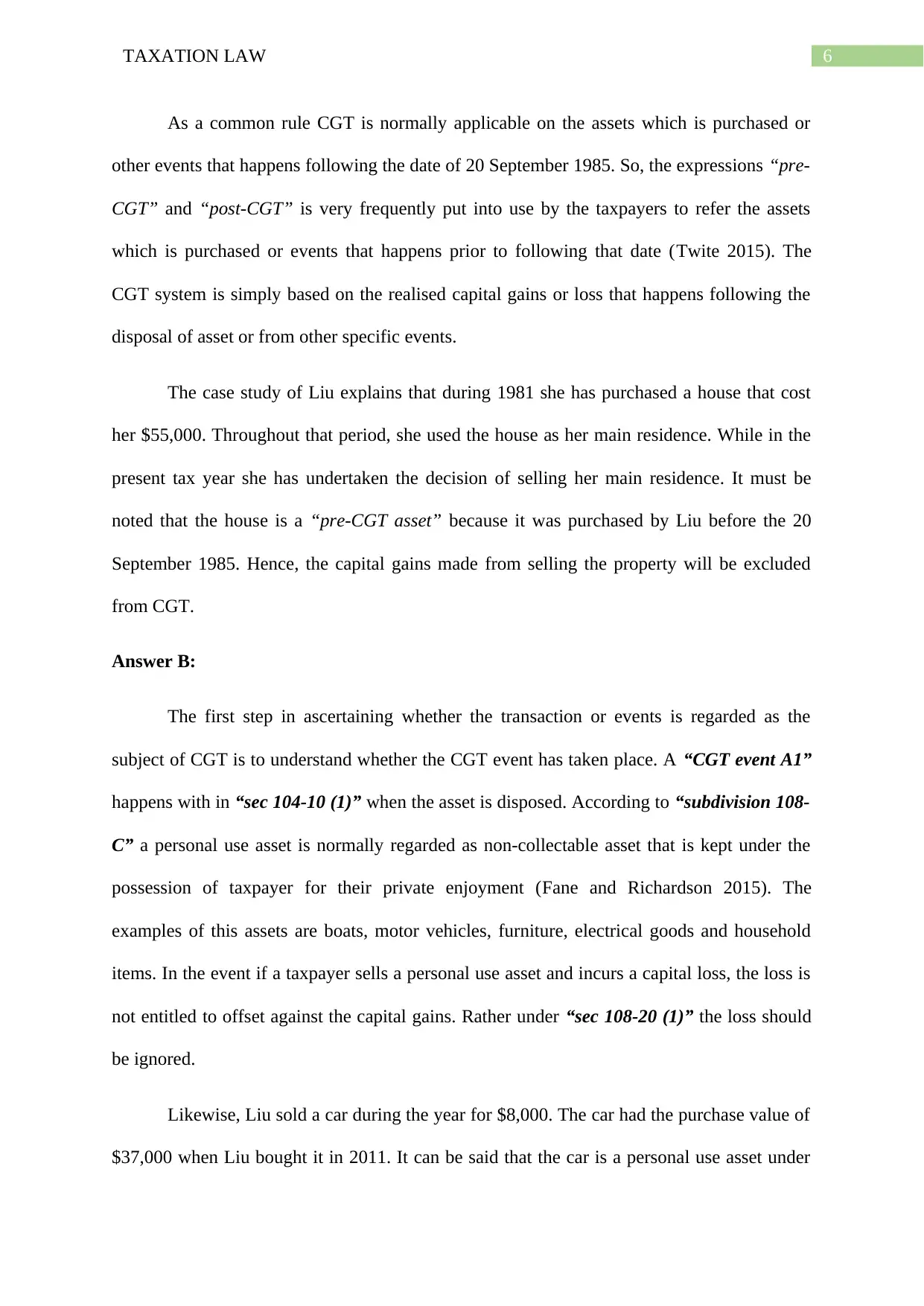
6TAXATION LAW
As a common rule CGT is normally applicable on the assets which is purchased or
other events that happens following the date of 20 September 1985. So, the expressions “pre-
CGT” and “post-CGT” is very frequently put into use by the taxpayers to refer the assets
which is purchased or events that happens prior to following that date (Twite 2015). The
CGT system is simply based on the realised capital gains or loss that happens following the
disposal of asset or from other specific events.
The case study of Liu explains that during 1981 she has purchased a house that cost
her $55,000. Throughout that period, she used the house as her main residence. While in the
present tax year she has undertaken the decision of selling her main residence. It must be
noted that the house is a “pre-CGT asset” because it was purchased by Liu before the 20
September 1985. Hence, the capital gains made from selling the property will be excluded
from CGT.
Answer B:
The first step in ascertaining whether the transaction or events is regarded as the
subject of CGT is to understand whether the CGT event has taken place. A “CGT event A1”
happens with in “sec 104-10 (1)” when the asset is disposed. According to “subdivision 108-
C” a personal use asset is normally regarded as non-collectable asset that is kept under the
possession of taxpayer for their private enjoyment (Fane and Richardson 2015). The
examples of this assets are boats, motor vehicles, furniture, electrical goods and household
items. In the event if a taxpayer sells a personal use asset and incurs a capital loss, the loss is
not entitled to offset against the capital gains. Rather under “sec 108-20 (1)” the loss should
be ignored.
Likewise, Liu sold a car during the year for $8,000. The car had the purchase value of
$37,000 when Liu bought it in 2011. It can be said that the car is a personal use asset under
As a common rule CGT is normally applicable on the assets which is purchased or
other events that happens following the date of 20 September 1985. So, the expressions “pre-
CGT” and “post-CGT” is very frequently put into use by the taxpayers to refer the assets
which is purchased or events that happens prior to following that date (Twite 2015). The
CGT system is simply based on the realised capital gains or loss that happens following the
disposal of asset or from other specific events.
The case study of Liu explains that during 1981 she has purchased a house that cost
her $55,000. Throughout that period, she used the house as her main residence. While in the
present tax year she has undertaken the decision of selling her main residence. It must be
noted that the house is a “pre-CGT asset” because it was purchased by Liu before the 20
September 1985. Hence, the capital gains made from selling the property will be excluded
from CGT.
Answer B:
The first step in ascertaining whether the transaction or events is regarded as the
subject of CGT is to understand whether the CGT event has taken place. A “CGT event A1”
happens with in “sec 104-10 (1)” when the asset is disposed. According to “subdivision 108-
C” a personal use asset is normally regarded as non-collectable asset that is kept under the
possession of taxpayer for their private enjoyment (Fane and Richardson 2015). The
examples of this assets are boats, motor vehicles, furniture, electrical goods and household
items. In the event if a taxpayer sells a personal use asset and incurs a capital loss, the loss is
not entitled to offset against the capital gains. Rather under “sec 108-20 (1)” the loss should
be ignored.
Likewise, Liu sold a car during the year for $8,000. The car had the purchase value of
$37,000 when Liu bought it in 2011. It can be said that the car is a personal use asset under
Paraphrase This Document
Need a fresh take? Get an instant paraphrase of this document with our AI Paraphraser
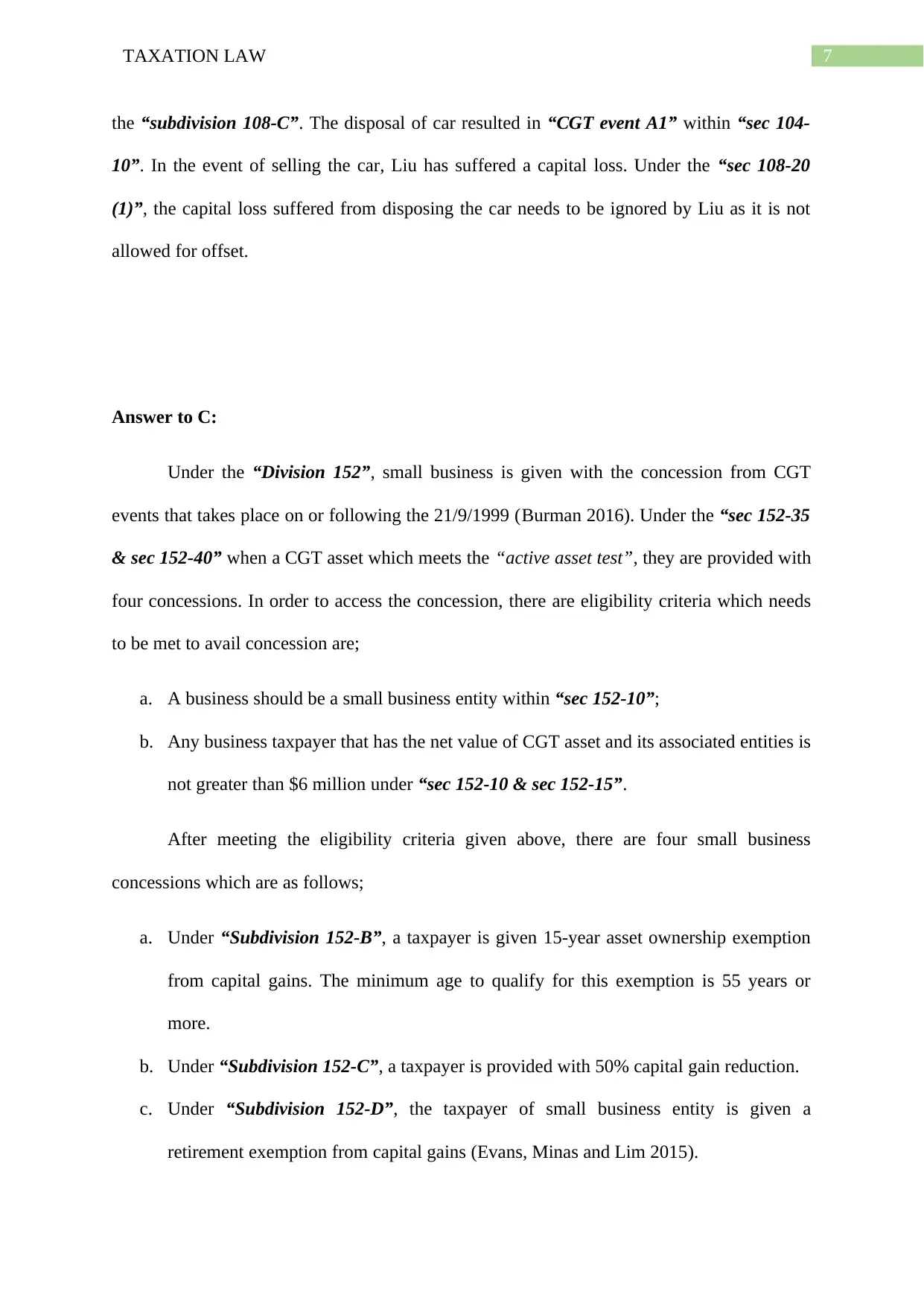
7TAXATION LAW
the “subdivision 108-C”. The disposal of car resulted in “CGT event A1” within “sec 104-
10”. In the event of selling the car, Liu has suffered a capital loss. Under the “sec 108-20
(1)”, the capital loss suffered from disposing the car needs to be ignored by Liu as it is not
allowed for offset.
Answer to C:
Under the “Division 152”, small business is given with the concession from CGT
events that takes place on or following the 21/9/1999 (Burman 2016). Under the “sec 152-35
& sec 152-40” when a CGT asset which meets the “active asset test”, they are provided with
four concessions. In order to access the concession, there are eligibility criteria which needs
to be met to avail concession are;
a. A business should be a small business entity within “sec 152-10”;
b. Any business taxpayer that has the net value of CGT asset and its associated entities is
not greater than $6 million under “sec 152-10 & sec 152-15”.
After meeting the eligibility criteria given above, there are four small business
concessions which are as follows;
a. Under “Subdivision 152-B”, a taxpayer is given 15-year asset ownership exemption
from capital gains. The minimum age to qualify for this exemption is 55 years or
more.
b. Under “Subdivision 152-C”, a taxpayer is provided with 50% capital gain reduction.
c. Under “Subdivision 152-D”, the taxpayer of small business entity is given a
retirement exemption from capital gains (Evans, Minas and Lim 2015).
the “subdivision 108-C”. The disposal of car resulted in “CGT event A1” within “sec 104-
10”. In the event of selling the car, Liu has suffered a capital loss. Under the “sec 108-20
(1)”, the capital loss suffered from disposing the car needs to be ignored by Liu as it is not
allowed for offset.
Answer to C:
Under the “Division 152”, small business is given with the concession from CGT
events that takes place on or following the 21/9/1999 (Burman 2016). Under the “sec 152-35
& sec 152-40” when a CGT asset which meets the “active asset test”, they are provided with
four concessions. In order to access the concession, there are eligibility criteria which needs
to be met to avail concession are;
a. A business should be a small business entity within “sec 152-10”;
b. Any business taxpayer that has the net value of CGT asset and its associated entities is
not greater than $6 million under “sec 152-10 & sec 152-15”.
After meeting the eligibility criteria given above, there are four small business
concessions which are as follows;
a. Under “Subdivision 152-B”, a taxpayer is given 15-year asset ownership exemption
from capital gains. The minimum age to qualify for this exemption is 55 years or
more.
b. Under “Subdivision 152-C”, a taxpayer is provided with 50% capital gain reduction.
c. Under “Subdivision 152-D”, the taxpayer of small business entity is given a
retirement exemption from capital gains (Evans, Minas and Lim 2015).
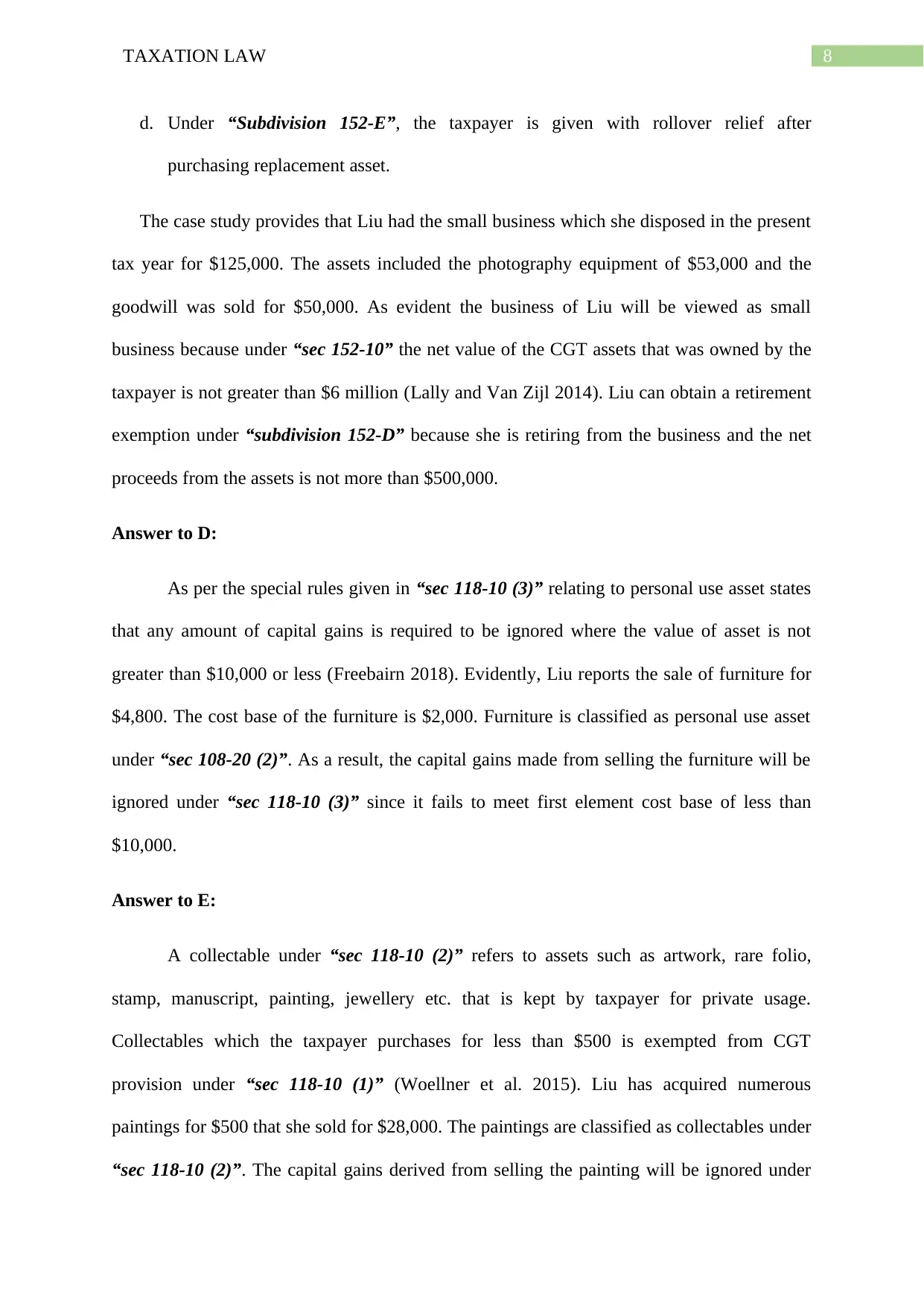
8TAXATION LAW
d. Under “Subdivision 152-E”, the taxpayer is given with rollover relief after
purchasing replacement asset.
The case study provides that Liu had the small business which she disposed in the present
tax year for $125,000. The assets included the photography equipment of $53,000 and the
goodwill was sold for $50,000. As evident the business of Liu will be viewed as small
business because under “sec 152-10” the net value of the CGT assets that was owned by the
taxpayer is not greater than $6 million (Lally and Van Zijl 2014). Liu can obtain a retirement
exemption under “subdivision 152-D” because she is retiring from the business and the net
proceeds from the assets is not more than $500,000.
Answer to D:
As per the special rules given in “sec 118-10 (3)” relating to personal use asset states
that any amount of capital gains is required to be ignored where the value of asset is not
greater than $10,000 or less (Freebairn 2018). Evidently, Liu reports the sale of furniture for
$4,800. The cost base of the furniture is $2,000. Furniture is classified as personal use asset
under “sec 108-20 (2)”. As a result, the capital gains made from selling the furniture will be
ignored under “sec 118-10 (3)” since it fails to meet first element cost base of less than
$10,000.
Answer to E:
A collectable under “sec 118-10 (2)” refers to assets such as artwork, rare folio,
stamp, manuscript, painting, jewellery etc. that is kept by taxpayer for private usage.
Collectables which the taxpayer purchases for less than $500 is exempted from CGT
provision under “sec 118-10 (1)” (Woellner et al. 2015). Liu has acquired numerous
paintings for $500 that she sold for $28,000. The paintings are classified as collectables under
“sec 118-10 (2)”. The capital gains derived from selling the painting will be ignored under
d. Under “Subdivision 152-E”, the taxpayer is given with rollover relief after
purchasing replacement asset.
The case study provides that Liu had the small business which she disposed in the present
tax year for $125,000. The assets included the photography equipment of $53,000 and the
goodwill was sold for $50,000. As evident the business of Liu will be viewed as small
business because under “sec 152-10” the net value of the CGT assets that was owned by the
taxpayer is not greater than $6 million (Lally and Van Zijl 2014). Liu can obtain a retirement
exemption under “subdivision 152-D” because she is retiring from the business and the net
proceeds from the assets is not more than $500,000.
Answer to D:
As per the special rules given in “sec 118-10 (3)” relating to personal use asset states
that any amount of capital gains is required to be ignored where the value of asset is not
greater than $10,000 or less (Freebairn 2018). Evidently, Liu reports the sale of furniture for
$4,800. The cost base of the furniture is $2,000. Furniture is classified as personal use asset
under “sec 108-20 (2)”. As a result, the capital gains made from selling the furniture will be
ignored under “sec 118-10 (3)” since it fails to meet first element cost base of less than
$10,000.
Answer to E:
A collectable under “sec 118-10 (2)” refers to assets such as artwork, rare folio,
stamp, manuscript, painting, jewellery etc. that is kept by taxpayer for private usage.
Collectables which the taxpayer purchases for less than $500 is exempted from CGT
provision under “sec 118-10 (1)” (Woellner et al. 2015). Liu has acquired numerous
paintings for $500 that she sold for $28,000. The paintings are classified as collectables under
“sec 118-10 (2)”. The capital gains derived from selling the painting will be ignored under
⊘ This is a preview!⊘
Do you want full access?
Subscribe today to unlock all pages.

Trusted by 1+ million students worldwide
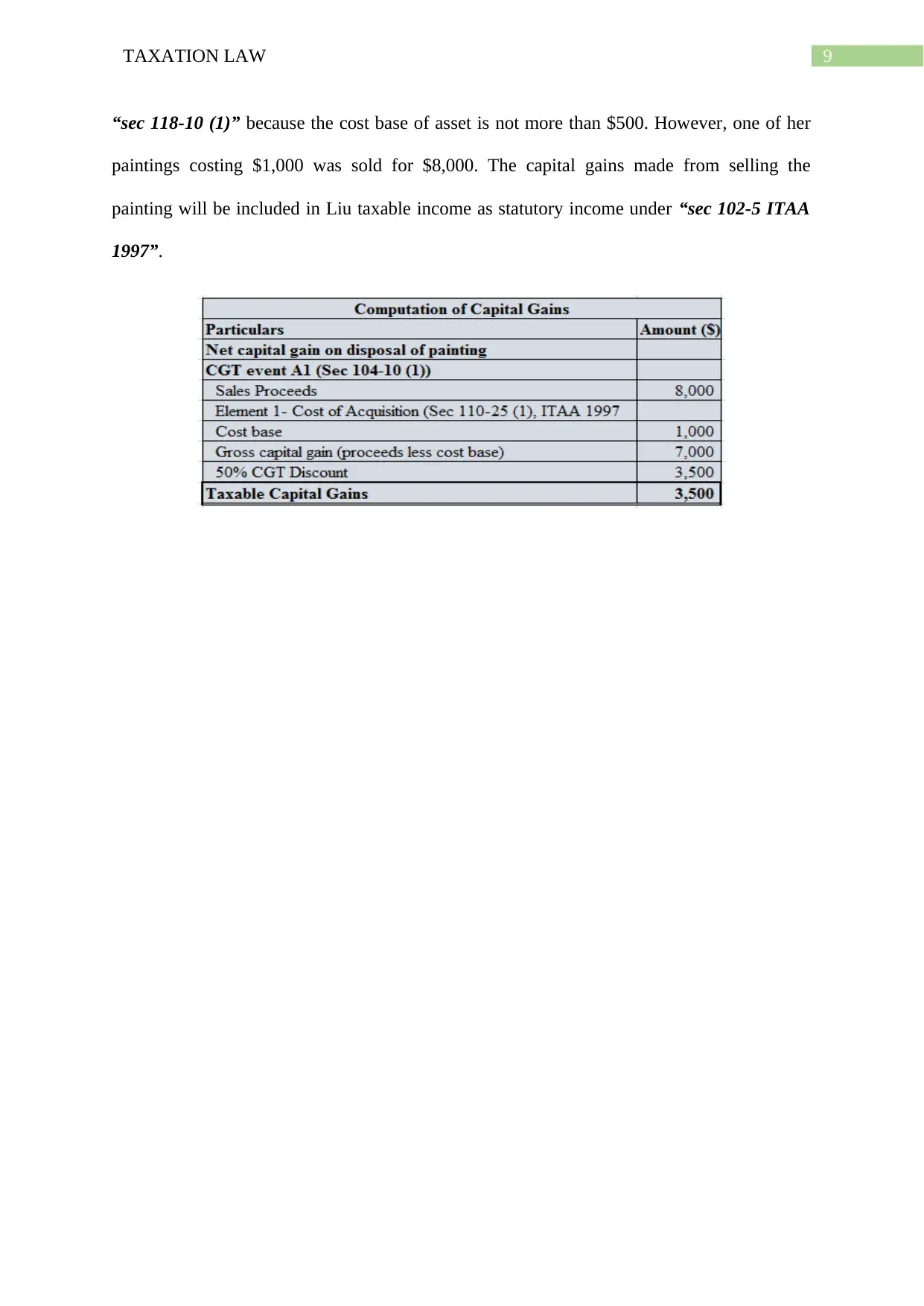
9TAXATION LAW
“sec 118-10 (1)” because the cost base of asset is not more than $500. However, one of her
paintings costing $1,000 was sold for $8,000. The capital gains made from selling the
painting will be included in Liu taxable income as statutory income under “sec 102-5 ITAA
1997”.
“sec 118-10 (1)” because the cost base of asset is not more than $500. However, one of her
paintings costing $1,000 was sold for $8,000. The capital gains made from selling the
painting will be included in Liu taxable income as statutory income under “sec 102-5 ITAA
1997”.
Paraphrase This Document
Need a fresh take? Get an instant paraphrase of this document with our AI Paraphraser
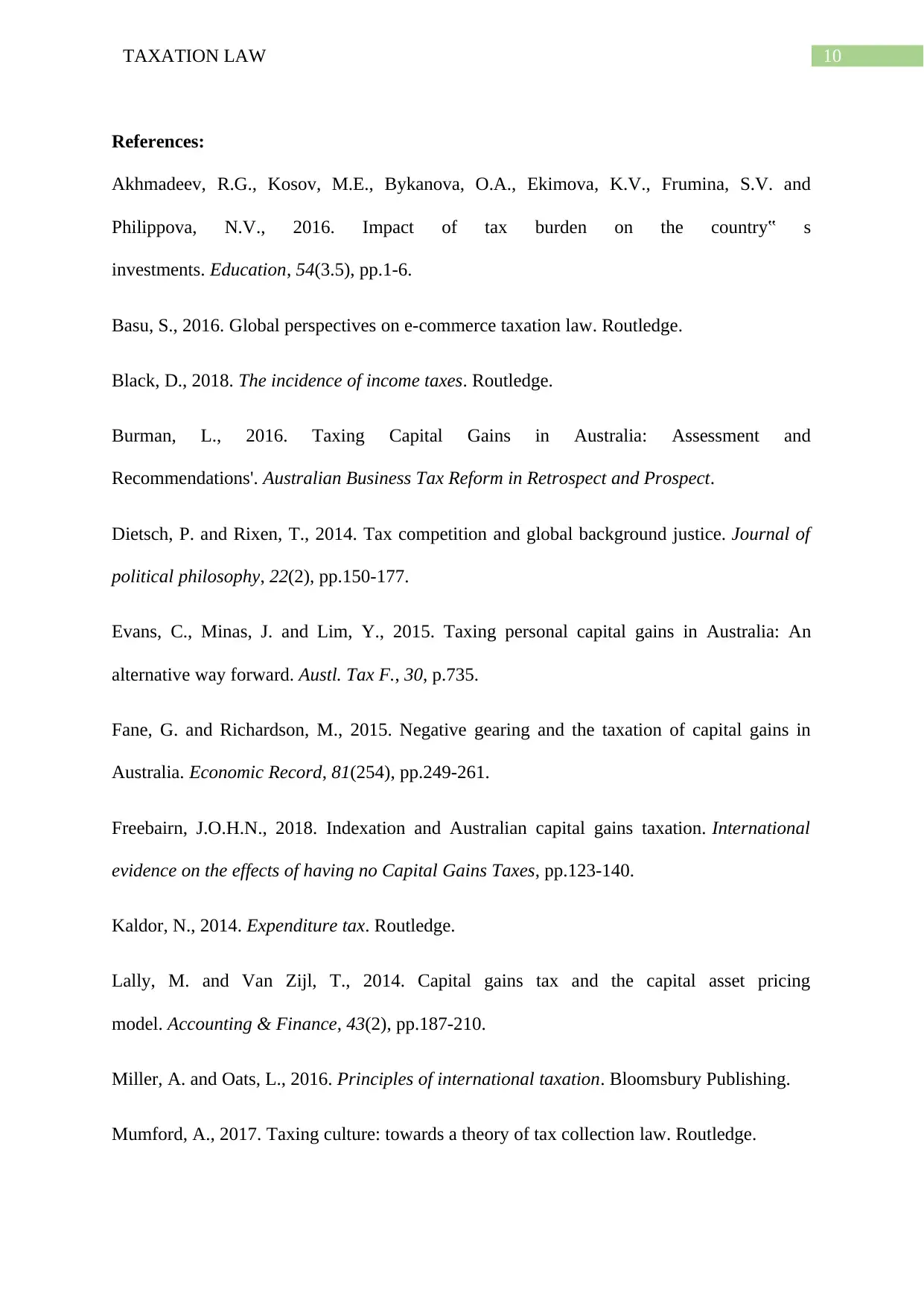
10TAXATION LAW
References:
Akhmadeev, R.G., Kosov, M.E., Bykanova, O.A., Ekimova, K.V., Frumina, S.V. and
Philippova, N.V., 2016. Impact of tax burden on the country‟ s
investments. Education, 54(3.5), pp.1-6.
Basu, S., 2016. Global perspectives on e-commerce taxation law. Routledge.
Black, D., 2018. The incidence of income taxes. Routledge.
Burman, L., 2016. Taxing Capital Gains in Australia: Assessment and
Recommendations'. Australian Business Tax Reform in Retrospect and Prospect.
Dietsch, P. and Rixen, T., 2014. Tax competition and global background justice. Journal of
political philosophy, 22(2), pp.150-177.
Evans, C., Minas, J. and Lim, Y., 2015. Taxing personal capital gains in Australia: An
alternative way forward. Austl. Tax F., 30, p.735.
Fane, G. and Richardson, M., 2015. Negative gearing and the taxation of capital gains in
Australia. Economic Record, 81(254), pp.249-261.
Freebairn, J.O.H.N., 2018. Indexation and Australian capital gains taxation. International
evidence on the effects of having no Capital Gains Taxes, pp.123-140.
Kaldor, N., 2014. Expenditure tax. Routledge.
Lally, M. and Van Zijl, T., 2014. Capital gains tax and the capital asset pricing
model. Accounting & Finance, 43(2), pp.187-210.
Miller, A. and Oats, L., 2016. Principles of international taxation. Bloomsbury Publishing.
Mumford, A., 2017. Taxing culture: towards a theory of tax collection law. Routledge.
References:
Akhmadeev, R.G., Kosov, M.E., Bykanova, O.A., Ekimova, K.V., Frumina, S.V. and
Philippova, N.V., 2016. Impact of tax burden on the country‟ s
investments. Education, 54(3.5), pp.1-6.
Basu, S., 2016. Global perspectives on e-commerce taxation law. Routledge.
Black, D., 2018. The incidence of income taxes. Routledge.
Burman, L., 2016. Taxing Capital Gains in Australia: Assessment and
Recommendations'. Australian Business Tax Reform in Retrospect and Prospect.
Dietsch, P. and Rixen, T., 2014. Tax competition and global background justice. Journal of
political philosophy, 22(2), pp.150-177.
Evans, C., Minas, J. and Lim, Y., 2015. Taxing personal capital gains in Australia: An
alternative way forward. Austl. Tax F., 30, p.735.
Fane, G. and Richardson, M., 2015. Negative gearing and the taxation of capital gains in
Australia. Economic Record, 81(254), pp.249-261.
Freebairn, J.O.H.N., 2018. Indexation and Australian capital gains taxation. International
evidence on the effects of having no Capital Gains Taxes, pp.123-140.
Kaldor, N., 2014. Expenditure tax. Routledge.
Lally, M. and Van Zijl, T., 2014. Capital gains tax and the capital asset pricing
model. Accounting & Finance, 43(2), pp.187-210.
Miller, A. and Oats, L., 2016. Principles of international taxation. Bloomsbury Publishing.
Mumford, A., 2017. Taxing culture: towards a theory of tax collection law. Routledge.
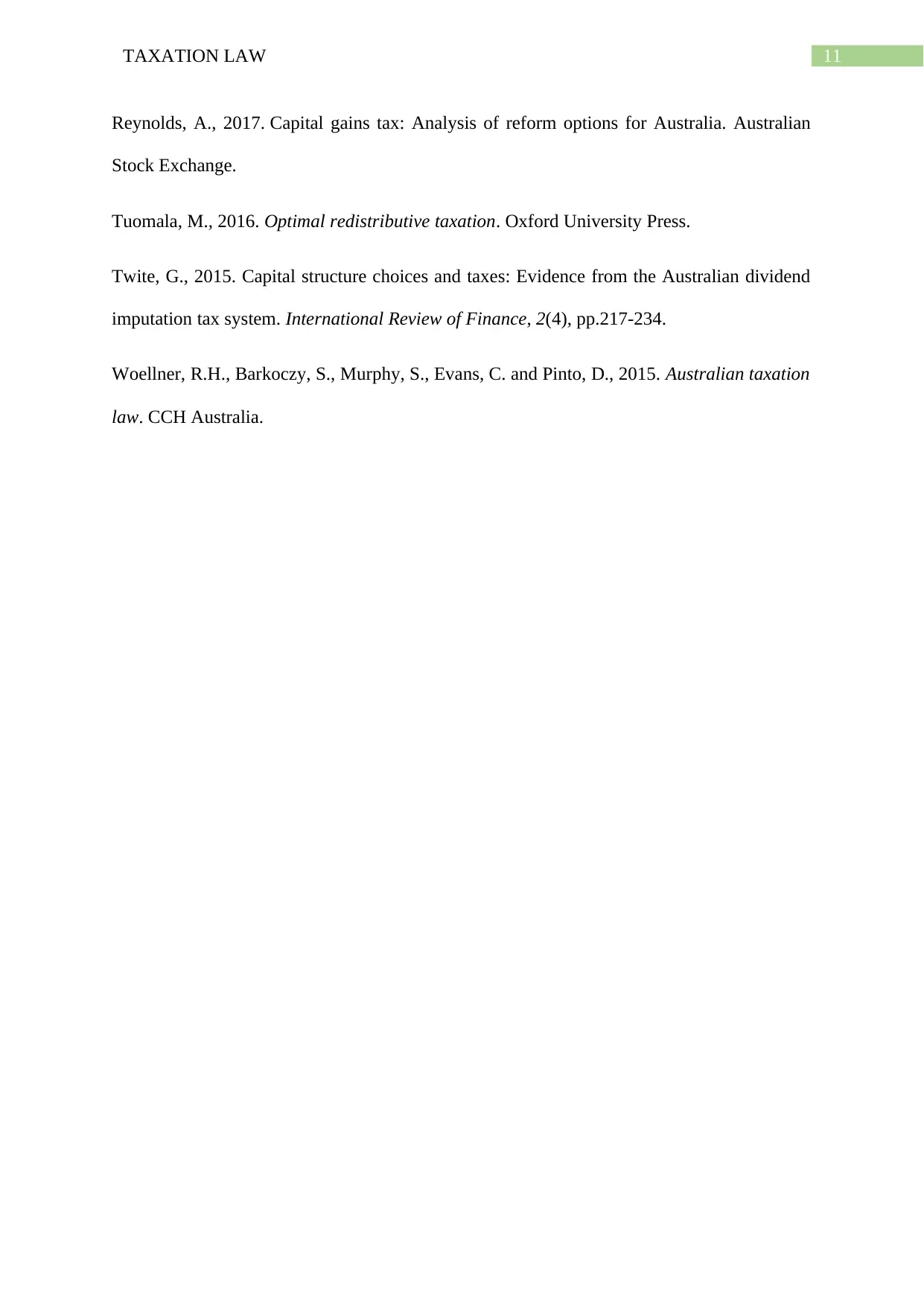
11TAXATION LAW
Reynolds, A., 2017. Capital gains tax: Analysis of reform options for Australia. Australian
Stock Exchange.
Tuomala, M., 2016. Optimal redistributive taxation. Oxford University Press.
Twite, G., 2015. Capital structure choices and taxes: Evidence from the Australian dividend
imputation tax system. International Review of Finance, 2(4), pp.217-234.
Woellner, R.H., Barkoczy, S., Murphy, S., Evans, C. and Pinto, D., 2015. Australian taxation
law. CCH Australia.
Reynolds, A., 2017. Capital gains tax: Analysis of reform options for Australia. Australian
Stock Exchange.
Tuomala, M., 2016. Optimal redistributive taxation. Oxford University Press.
Twite, G., 2015. Capital structure choices and taxes: Evidence from the Australian dividend
imputation tax system. International Review of Finance, 2(4), pp.217-234.
Woellner, R.H., Barkoczy, S., Murphy, S., Evans, C. and Pinto, D., 2015. Australian taxation
law. CCH Australia.
⊘ This is a preview!⊘
Do you want full access?
Subscribe today to unlock all pages.

Trusted by 1+ million students worldwide
1 out of 12
Related Documents
Your All-in-One AI-Powered Toolkit for Academic Success.
+13062052269
info@desklib.com
Available 24*7 on WhatsApp / Email
![[object Object]](/_next/static/media/star-bottom.7253800d.svg)
Unlock your academic potential
Copyright © 2020–2026 A2Z Services. All Rights Reserved. Developed and managed by ZUCOL.





